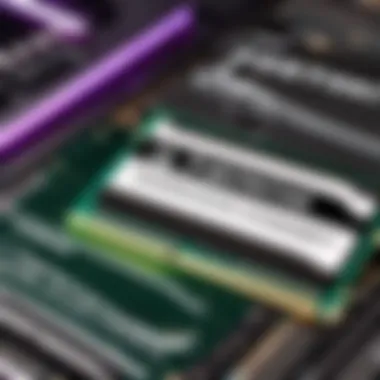Key PC Specs for Peak Fortnite Gaming Performance


Intro
In the fast-paced realm of Fortnite, the thrill of victory often hinges on one’s hardware. As gamers chase the elusive Victory Royale, the importance of possessing the right PC specs cannot be overstated. Each element of a gaming rig, from the CPU to the GPU and RAM, plays a vital role in determining performance metrics such as frame rates and loading times. With constant updates and evolving gameplay mechanics, ensuring your setup is optimal is key to staying competitive.
This guide will delve into the essential specifications required to optimize your Fortnite experience. Whether you’re a casual player or an aspiring pro, understanding what components to prioritize can mean the difference between a smooth game and frustrating lags. Let's take a deeper dive into what you need for peak performance.
Intro to PC Specs in Gaming
When it comes to diving into the digital battleground of gaming, the specifications of your PC are like the muscles of a race car; they determine how well you can perform under pressure. Each player, whether a relaxed participant or a competitive athlete, needs to commune with their hardware to guarantee a seamless experience. Hence, understanding the essentials of PC specifications is vital for anyone looking to enhance their Fortnite experience.
In this section, we’ll peel back the layers of what specifications mean for gaming, particularly focusing on Fortnite, a title that has captured the hearts of players worldwide. You might be asking, why all the fuss about specs? Well, high specifications can often make or break your gameplay. They impact everything from your frame rate to your loading times. When you have a system that mirrors the intricate dance of pixels and performance that Fortnite offers, you're not just playing the game; you're living it.
The Impact of Specifications on Gaming
In the world of gaming, specifications are like the secret sauce in a famous recipe; you don’t often see them, but they drastically influence the final product. Every component, be it CPU, GPU, RAM, or storage, all play a role in shaping your experience. A well-balanced system with a powerful CPU and GPU can lead to smoother gameplay and higher frame rates, allowing you to react faster than a heartbeat in critical moments.
When your hardware is fit to tackle the mesmerizing visuals and rapid gameplay of Fortnite, you’ll find yourself less prone to glitches or stutters. Increased frame rates can lead to a noticeable difference in your reaction times. Instead of battling against system delays, you can fully immerse yourself into the chaos of the arena.
Without quality specifications, players can feel like they’re trudging through molasses, missing that critical opportunity to build or fire at an enemy swiftly. Good specs lend a smooth interface, keeping your skills sharp and focused. A poorly equipped setup could result in disadvantages too great to overcome, underscoring why understanding specs is imperative.
Why Fortnite Demands Specific Hardware
Fortnite isn’t just another game; it’s a vibrant world where every moment counts. With its colorful graphics and dynamic gameplay, the demands for hardware can catch some players off guard. Unlike traditional console games, Fortnite’s constantly shifting landscape requires not just capability but a certain finesse from your hardware.
Here’s where things get interesting. Fortnite often updates with new features, events, and enhancements. This means that the hardware you choose today might need to be reassessed tomorrow. Players must recognize that investing in higher-quality hardware today can safeguard their experiences tomorrow.
Several components are crucial. For instance, having a powerful GPU ensures that the game runs smoothly and can handle complex scenes without hiccups. RAM size should not be overlooked either; players benefit immensely from having sufficient memory to ensure it loads quickly and runs efficiently. An inadequate setup may cause experiences that are less than ideal, turning what should be exhilarating gameplay into frustrating lags and crashes.
It’s clear that Fortnite’s unique requirements dictate a more advanced approach to PC specs. By understanding why certain hardware is demanded, players can better navigate their choices and invest wisely in their gaming rig. By paying attention to these details, you can ensure you’re well-prepared to take on anything the island throws your way.
Understanding Key Components
When it comes to gaming on a PC, particularly for a fast-paced title like Fortnite, understanding key components is crucial. Each part of your system plays a significant role in delivering the performance you desire. Knowing what the core elements are will help you tailor your build or upgrade to better suit your gameplay style and efficiency. Let’s break down these components to grasp their impact on gaming performance.
Central Processing Unit (CPU)
Importance of Clock Speed
Clock speed, measured in gigahertz (GHz), indicates how fast a CPU can process transactions. Higher clock speeds generally mean more instructions can be executed per second. In the context of Fortnite, this can significantly affect frame rates because a speedy CPU will handle in-game calculations rapidly.
A popular choice, like the AMD Ryzen 5, boasts impressive clock rates. Gamers favor it because it balances price and performance, making it accessible. However, higher speeds typically mean more heat; therefore, adequate cooling solutions are essential.
Core Count Considerations
While clock speed is vital, core count cannot be ignored. The number of cores affects how your CPU multitasks. Fortnite can take advantage of multiple cores, especially in complex situations like building structures or when many players are on-screen.
A 6-core CPU, for example, may perform noticeably better than a 4-core when running Fortnite alongside streaming software or other applications. However, it’s helpful to note that not all games demand high core counts, sometimes making a faster 4-core more suitable for competitive play.
Graphics Processing Unit (GPU)
Choosing the Right GPU


The GPU essentially drives visual fidelity and performance in any game. For Fortnite, a dedicated graphics card is a must. When selecting a GPU, consider factors like brand reputation, benchmark scores, and how it can render high-quality textures at the required frame rates.
NVIDIA's GeForce RTX series, particularly the 3060, is commonly sought after among Fortnite enthusiasts. This series supports ray tracing, adding realism to the game without sacrificing performance. However, with great power comes higher temps and energy consumption, so ensuring your build can handle it is key.
VRAM Capacity Explained
Video RAM (VRAM) plays a significant role in how smoothly a game runs at higher resolutions. When you opt for higher resolutions or multi-monitor setups, the demand for VRAM increases. Ideally, 6GB of VRAM is advisable for Fortnite, as it allows better handling of graphics at higher settings.
Lesser VRAM can lead to stuttering or frame drops during intense gameplay scenarios, especially during in-game events. Choosing a GPU with an adequate VRAM ensures optimal performance, thus enhancing your overall gaming experience.
Random Access Memory (RAM)
Optimal RAM Size for Gaming
Random Access Memory is like short-term memory for your PC. For Fortnite, you should aim for at least 16GB of RAM. More RAM allows for smoother transitions between game states and reduces load times. With newer updates, Fortnite demands more from your system; having enough RAM helps future-proof your gaming setup.
However, overkill isn’t necessary. Having 32GB might seem appealing but won't significantly improve gaming performance itself unless you're multitasking heavily or editing videos.
Types of RAM and Their Significance
Different types of RAM can influence your system's performance too. Regular DDR4 is standard for most gaming PCs, but the speed (measured in MT/s) makes a big difference. Faster RAM, like DDR4-3200, allows for quicker data access compared to slower options, contributing to overall system responsiveness.
While lower latency RAM might seem appealing, the difference in gaming performance isn’t always significant. Instead, focus on reliable and compatible RAM to ensure max stability during gameplay.
Storage Solutions
SSD vs. HDD for Gaming
The type of storage you choose impacts load times and game responsiveness. Solid State Drives (SSDs) are the preferred choice for gaming today. They can drastically reduce loading times compared to traditional Hard Disk Drives (HDDs). For instance, when you drop into Fortnite’s island, SSDs can load the game in seconds, giving you an edge over competitors with slower drives.
Yet, HDDs still have their place, primarily in storing larger files. They provide significant capacity at lower costs, but for active gaming, making the switch to an SSD can be a game changer.
Read and Write Speeds Impact
Read and write speeds determine how fast data is accessed and stored. For gaming, SSDs outperform HDDs substantially due to their rapid read/write capabilities. A game like Fortnite benefits from this, as it frequently loads new areas and assets without lag. While most SSDs offer commendable speeds, NVMe SSDs take it up a notch with even faster transfer rates.
In summary, understanding these critical components—CPU, GPU, RAM, and Storage—allows gamers to build a system capable of handling Fortnite's demands effectively. Choosing the right specifications tailored to how you play is what will ultimately lead to an enhanced gaming experience.
Determining Your Gaming Needs
Understanding your gaming needs is essential for achieving optimum performance in Fortnite. Every gamer possesses unique preferences and expectations that shape the specifications needed for their systems. This section delves into important considerations like play style, competitive aspirations, and graphics preferences, which are crucial in determining how one should configure their PC.
The right specifications can not only enhance your gameplay experience but also make a significant difference in your performance—especially in a fast-paced game like Fortnite, where each frame counts.
Casual Players vs. Competitive Gamers
In the realm of gaming, distinguishing between casual players and competitive gamers is pivotal. Casual gamers might prioritize a fun experience over bleeding-edge frame rates. They may enjoy high settings for visuals without stressing about hitting the peak frame rates. For these players, a solid mid-range GPU might be sufficient, along with adequate RAM to support smooth gameplay.
On the other hand, competitive gamers usually seek every possible advantage. They know that any hiccup in performance can cost them during intense matchups. For this reason, they often invest in high-performance CPUs and GPUs, along with high refresh rate monitors, to ensure they have the best tools at their disposal.
Key Considerations for Different Types of Gamers:


- Casual Players:
- Competitive Gamers:
- Focus on a balance between visuals and performance
- May lean towards popular brands like NVIDIA or AMD for decent mid-range cards
- Sufficient RAM (16GB is often enough)
- High-end components like the latest GPUs and high clock-speed CPUs
- Priority on low latency and stable frame rates
- Upgrading to 32GB RAM for future-proofing
Preferred Graphics Settings
After classifying your gaming style, the next step is to determine your preferred graphics settings. Fortnite allows players to customize their experience through various settings such as resolution, texture quality, and post-processing effects. These settings play a significant role in the overall performance and visual appeal of the game.
For instance, players inclined to prioritize performance over aesthetics might reduce shadow quality and effects to gain higher frames per second (FPS). This can lead to a more fluid and responsive experience, which is especially beneficial in competitive scenarios.
Conversely, individuals who appreciate stunning visuals may want to enable higher settings. However, they must ensure their system can handle it, as pushing settings too high on underpowered hardware can lead to choppy gameplay.
"Optimizing graphics settings is a balancing act, where every choice weighs between performance and visual fidelity."
Typical Preferred Settings by Type of Gamer:
- **Casual Players:
- Competitive Gamers:
- Higher graphics settings for aesthetic enjoyment
- Resolution settings like 1080p or even 1440p
- Lower graphics settings for maximum FPS
- Commonly stick to 1080p with focus on visibility
Budget Considerations
When diving into the realm of gaming PCs, particularly for Fortnite, budget is undeniably one of the most critical aspects to consider. Finding the sweet spot between cost and performance can make or break your gaming experience. With so many options out there, it’s easy to feel overwhelmed, but understanding your budgetary constraints alongside your gaming needs can help narrow down choices considerably.
Finding the Balance Between Cost and Performance
In today’s market, it is tempting to chase the latest high-performance hardware. However, splashing out on every component doesn’t always translate to a significant boost in performance. Here’s where balancing act comes into play:
- Prioritize Components: Allocate your budget wisely. Usually, a good GPU and CPU will yield the most pronounced benefits. Skimping on these may lead to subpar gaming experiences.
- Consider Resale Value: Some components hold their value better than others. For instance, high-demand GPUs can be sold later on, helping recoup some of the initial investment.
- Research Before Buying: Keeping an eye on sales and ever-changing prices helps tremendously. Platforms like Reddit often discuss ongoing deals and trends, allowing savvy buyers to snag excellent hardware without breaking the bank.
By thoughtfully navigating these factors, you set yourself up for a gaming rig that both meets your needs and respects your financial limits.
Future-Proofing Your Setup
Trying to keep up with gaming technology can feel like running a marathon on a treadmill—always in motion but never making progress. That’s where the concept of future-proofing kicks in. Here’s how to ensure your investment lasts:
- Opt for Expandability: When selecting a motherboard, choose one that allows for additional RAM or more powerful GPUs in the future. This little foresight pays off down the line.
- Select Components Wisely: Aim for parts that not only meet today's gaming standards but also have the capacity to handle future advancements—like a GPU that supports ray tracing.
- Keep Software Updated: Frequently updating drivers and installing the latest patches for Fortnite is essential. This keeps your system running optimally on current game versions.
"Investing thoughtfully today can keep your setup relevant for years to come."
Building vs. Buying a Gaming PC
When considering how to approach your gaming setup, the choice between building and buying a gaming PC takes center stage. Each option has its merits, hinging on aspects like cost, personalization, upgradability, and your own technical skills. Understanding this decision is especially crucial for Fortnite enthusiasts aiming for top-tier performance, as the right choice can significantly affect gameplay experience.
Advantages of Building Your Own PC
Building your own PC can seem like a daunting task, yet it offers several compelling advantages. One of the primary benefits is the cost-effectiveness. When you piece together a system, you can allocate funds precisely where you see fit, perhaps skimping on less critical components and splurging on a high-quality GPU that boosts your Fortnite frame rates.


Furthermore, constructing a PC allows for customization tailored to your gaming needs. These days, it’s easy to find numerous online resources that provide step-by-step guides for building a computer. This not only caters to individual preferences in hardware but also lets you select components that synchronize well with Fortnite, like optimized cooling solutions or high-frequency RAM.
Consider also the pride that comes with assembling your own machine. There’s a unique satisfaction in knowing the intricacies of your setup. Plus, in terms of upgradability, a custom-built PC stands tall. When you build your own system, swapping out hardware becomes a breeze; you often know the ins and outs better than a pre-built model, making upgrades less intimidating.
"Building a PC is not just about gaming; it's about understanding how your machine works. It's a labor of love that pays off on the battlefield."
When to Consider Pre-Built Options
On the flip side, opting for pre-built PCs is a choice that should not be taken lightly either. Perhaps you're tight on time or feel utterly daunted by the prospect of assembling your rig. In these scenarios, a pre-built option may be your saving grace. These systems are often available quickly and allow you to jump right back into Fortnite without the hassle of gathering parts or deciphering what goes where.
However, one must not overlook the fact that pre-built systems can often come with a price tag that inflates compared to their DIY counterparts. Manufacturers generally mark up costs due to the convenience they offer, which can sometimes lead to compromises in components. It is essential to scrutinize the specs carefully before pulling the trigger, ensuring that you’re still getting a machine that can deliver that competitive edge.
Ultimately, the choice between building and buying is deeply personal. Factors like budget constraints, time limitations, and your comfort with technology will weigh heavily on your decision. Just remember, both paths lead you to your gaming goals, though each has its own twists and turns to consider as you pursue optimal Fortnite performance.
Monitoring and Optimizing Performance
In today’s fast-paced gaming environment, especially with games like Fortnite that demand rapid reflexes and sharp attention, keeping tabs on your PC's performance is crucial. The experience can go from thrilling to frustrating if your system isn't running at its best. Monitoring and optimizing performance not only helps in achieving smoother gameplay but also allows players to get the most out of their hardware investments. It’s akin to regularly checking the air pressure in your tires; a small adjustment can lead to a vastly improved experience.
Understanding Frame Rates and Resolution
Frame rate (measured in frames per second, or FPS) has become a buzzword among gamers. It dictates how smooth the animation looks; higher frame rates lead to more fluid motion. In Fortnite, where split-second decisions mean the difference between victory and defeat, getting your FPS right is a game changer.
When discussing resolution, it's vital to strike a balance. A higher resolution, like 1440p or even 4K, delivers stunning visuals but can push your GPU to its limits. You might be watching the beauty of the map, but if your frame rate drops while you're trying to dodge a sniper’s shot, that's a problem. Understanding this balance is key.
A few points to keep in mind:
- Optimal FPS for Competitive Play: For a competitive edge, aim for no less than 60 FPS. Many pro players target 144 FPS or higher, particularly when using high-refresh-rate monitors.
- Resolution Scaling: Consider lowering your resolution during intense skirmishes if frame rates start to dip. It’s about finding what works for you while keeping visuals appealing enough to not sacrifice enjoyment.
- Impacts on Reaction Time: A higher frame rate can significantly reduce input lag, making it easier to react to enemies or dodge incoming fire. If your frame rate is low, you may find yourself getting taken out before you even see the enemy.
By experimenting with various settings, players can discover the sweet spot that maximizes both visual quality and performance.
Utilizing Optimization Tools
Often overlooked, optimization tools can be a lifeline for gamers looking to squeeze out every ounce of performance from their machines. These tools perform various functions, from adjusting graphical settings to outright managing how programs utilize system resources. The aim here is simple: keep everything running smoothly with as little hitches as possible.
Some key tools and methods you can employ include:
- Monitoring Software: Applications like MSI Afterburner or HWMonitor offer insights into what’s happening inside your PC. They track performance metrics such as GPU temperature and memory usage, allowing adjustments as needed.
- Game Mode Settings: Utilizing built-in settings in Windows, such as Game Mode, can help prioritize system resources for Fortnite. This can reserve those valuable CPU cycles specifically for gaming, rather than letting background applications steal focus.
- Driver Updates: Keeping your GPU drivers up to date is non-negotiable. New drivers often come with performance enhancements and bug fixes, so it pays to stay ahead of the curve.
- In-game Settings: Don't shy away from delving into Fortnite's own settings. Tweaking graphics details like shadow quality or anti-aliasing can lead to significant performance gains without hefty sacrifices in visual appeal.
Many gamers find substantial gains by simply being proactive about what software they run and how they can tune their settings. In the end, it all leads to that much-lauded competitive edge, contributing to overall gaming efficiency.
"In gaming, every frame counts. Never underestimate the power of a well-optimized system."
Finale
Summarizing Key Takeaways
In revisiting the highlights from this piece, players should focus on:
- CPU Power: The Central Processing Unit isn't just another piece of hardware. It's the brain behind your operations, determining how effectively your system handles multiple tasks at once. Aim for a balance between core count and clock speed to maximize performance.
- Graphics Card Matters: Your Graphics Processing Unit directly influences frame rates and visual detail. Choosing a capable GPU with adequate VRAM will ensure smooth gameplay, especially during intense engagements.
- Memory Management: Random Access Memory plays a vital role in how quickly your system can respond. Having enough RAM not only ensures seamless gaming but also complements your CPU and GPU choices effectively.
- Storage Consideration: The type of storage can alter load times significantly. Opting for SSD over HDD can provide faster access to game files and quicker boot times, making for a more enjoyable gaming session.
- Budgeting for Performance: Whether you're building or buying, it's important to find a sweet spot between cost and performance that suits your gaming style while allowing room for future upgrades.
Overall, a well-rounded understanding of these specifications can set any gamer on the path to victory.
Next Steps for Gamers
For those ready to elevate their gaming experience, the way forward includes a few critical next steps:
- Assess Your Needs: Take time to pinpoint what you need most—are you a casual player or a competitive gamer? Understanding your gaming style will inform the type of hardware you should invest in.
- Research Hardware: Dive deep into reviews and comparisons of specific CPUs, GPUs, and RAM types. Websites like Wikipedia and Reddit can be excellent starting points.
- Consider Building Your PC: If you’re inclined towards DIY projects, building your own gaming PC can be highly rewarding both financially and in terms of personal satisfaction.
- Stay Updated: Technology is always advancing. Make it a habit to stay informed about the latest trends and improvements in gaming hardware. Following tech updates on platforms like Facebook can keep you in the loop.
In summary, take what you’ve learned and apply it to create a gaming setup tailored for success in Fortnite. This investment in knowledge will not only maximize your current gameplay but also serve you well in future gaming adventures.



